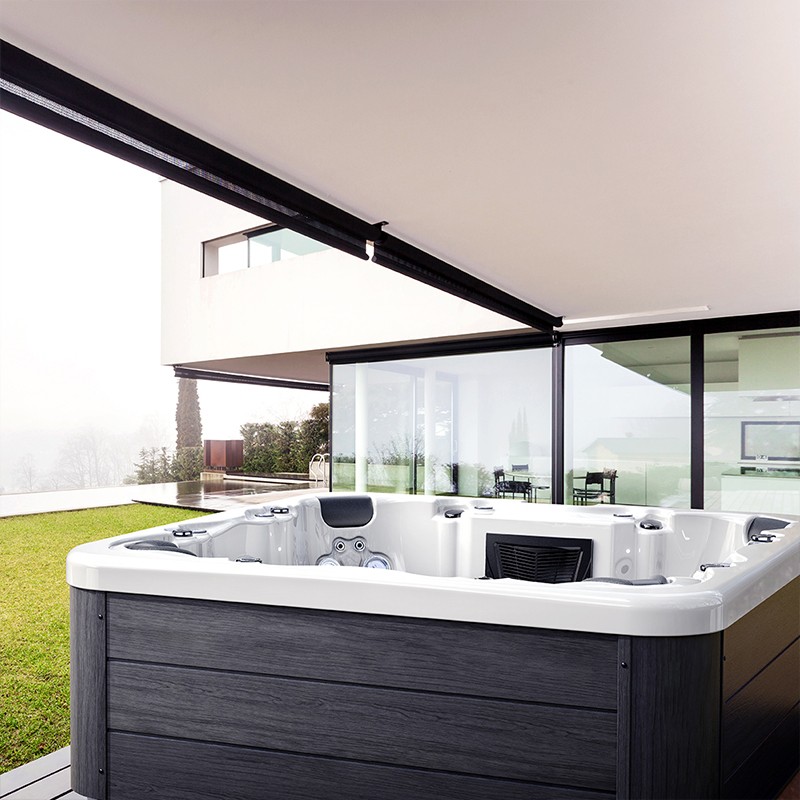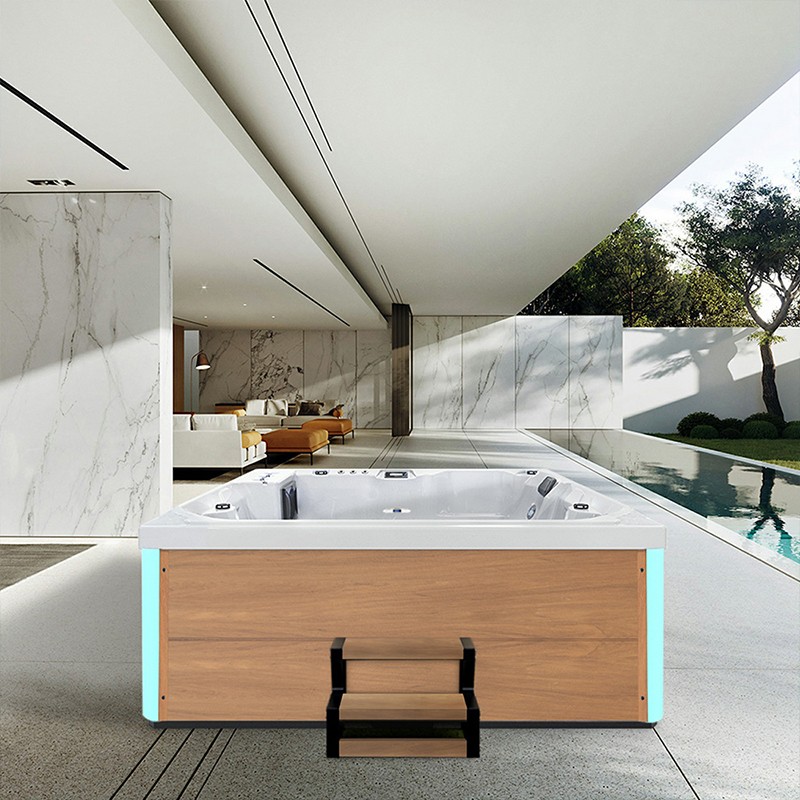
Why does the pH of my outdoor hot tub keep rising?
2025-02-03 15:35Owning an outdoor hot tub is a luxury that not only relaxes the mind and body, but also relieves fatigue and muscle tension. However, outdoor hot tubs are not easy to maintain, especially when it comes to controlling water quality. The balance of water quality is essential for health, the life of the equipment, and the overall bathing experience. The pH level is a key indicator in daily maintenance. It reflects the acidity and alkalinity of the water and should generally be maintained between 7.2 and 7.8. However, many users find that the pH of their outdoor hot bathtubs continues to rise, and even after constant adjustments, it still cannot stay within the normal range.
This article will take a closer look at why the pH of an outdoor hot tub keeps rising, the problems this situation may cause, and how to effectively deal with this phenomenon.

What is pH and why is it important?
First, understand the basic concept of pH. pH is the negative logarithm of the concentration of hydrogen ions in an aqueous solution, which reflects the acidity or alkalinity of the water. The pH scale ranges from 0 to 14, with a value of 7 indicating neutrality, below 7 being acidic, and above 7 being alkaline.
Maintaining the right pH in an outdoor hot tub is important for the following reasons:
1. Water balance: If the pH is too low (acidic), it can corrode metal parts, damage the surface of the tub, and even damage the filtration system. If the pH is too high (alkaline), the water will become cloudy and bacteria may grow more easily, affecting the healthy experience of bathing.
2. Chemical effectiveness: Disinfectants such as bromine and chlorine will be less effective in water with a high pH, resulting in poor sterilization and disinfection effects, which increases health risks.
3. Comfort: Water with a pH value that is not within the normal range may irritate the skin, eyes, and even cause respiratory discomfort.
Therefore, maintaining the right pH is not only related to the maintenance of the hot bathtub equipment, but also directly affects the health and comfort of the user.

Why does the pH continue to rise?
When the pH continues to rise, there may be multiple factors at work. Here are some common reasons for the pH to rise in outdoor hot tubs:
Sodium bicarbonate (increased alkalinity)
Alkalinity refers to the concentration of bicarbonate ions (HCO₃⁻) in water. Alkalinity not only affects the degree of pH fluctuation, but can also directly cause pH to rise. If the alkalinity in your outdoor hot bathtub is too high, the water's buffering capacity will increase, which will resist the drop in pH and cause the pH to gradually rise.
Many maintainers use alkalinity enhancers (usually containing sodium bicarbonate), but if these chemicals are overused, they will increase both alkalinity and pH. Therefore, high alkalinity in the water is often one of the main reasons for the pH to remain high for a long time.
Water Hardness (Too Much Calcium)
Water hardness refers to the amount of calcium and magnesium ions in the water. During water quality maintenance, it is usually necessary to maintain an appropriate hardness level (usually 100-200 ppm). However, if the water hardness is too high (too much calcium ion content), this may cause the pH to continue to rise. Excessively hard water can also cause scale accumulation, affecting the normal operation of the equipment and exacerbating pH fluctuations.
The hardness of the water in the outdoor hot tub is usually determined by the local water source. If the local water quality is hard, special attention needs to be paid when using it.
Evaporation and concentration of water
When an outdoor hot tub is exposed to sunlight or heated continuously, the water gradually evaporates. As the water evaporates, the minerals and alkaline chemicals dissolved in the water are retained, causing these substances to gradually concentrate in the water, which in turn causes the pH value to rise.
Especially in high temperatures and when the bath water is exposed for a long time, this evaporation effect will be aggravated, causing the concentration of alkaline substances in the water to increase, thereby pushing up the pH value.
Dissolution of gases (CO₂ escape)
Carbon dioxide (CO₂) in water reacts with water to form carbonic acid, which can lower the pH value of water. When the water in the hot bathtub is heated, the carbon dioxide dissolved in the water will gradually escape. As the CO₂ decreases, the acidity of the water decreases, the alkalinity increases, and the pH value rises accordingly.
Especially in outdoor hot tubs, when exposed to air, the water temperature rises, and the user frequently stirs the water, the escape of carbon dioxide is more obvious, which explains why the pH value often rises after hot bathtub use.
Improper use of chemicals
During routine maintenance, pH fluctuations can occur if the wrong chemicals are used or not added correctly according to instructions. Some chemicals used for disinfection, such as bromine or chlorine, often affect the pH of the water. Some disinfectants, such as sodium hypochlorite (liquid chlorine), are inherently highly alkaline, which can cause the pH to rise over time.
In addition, some users may overdose on pH boosters to adjust the water quality, which can also be one of the reasons for the high pH.
Addition of new water
Newly added tap water usually contains a certain amount of minerals and bicarbonate, which can affect the alkalinity and pH of the water. Especially in hard water areas, the high content of bicarbonate ions in tap water can cause alkalinity to rise after being added to the outdoor hot bathtub, causing the pH to continue to rise.

What are the dangers of high pH?
Continuously elevated pH has many negative effects on the use and maintenance of outdoor hot bathtubs, including effects on health, equipment, and water quality.
Equipment damage
Water with too high a pH value is alkaline, and long-term contact with the metal parts of the bathtub (such as heaters, nozzles, pipes, etc.) will cause corrosion of these parts and shorten their service life. In addition, too high a pH value may also cause calcium precipitation, and scale will accumulate inside pipes and nozzles, clogging equipment and affecting water circulation.
Water quality deterioration
When the pH value increases, the efficiency of disinfectants (such as bromine and chlorine) will be greatly reduced, leading to the growth of bacteria and algae. Disinfectants are less effective in high pH environments, and the water quality is more likely to become turbid, and even green or brown algae may appear.
Skin and eye irritation
Water with too high a pH value will irritate the user's skin and eyes, causing dryness, itching, and even red spots or rashes. When the eyes come into contact with overly alkaline water, it will cause discomfort such as stinging, redness, and tearing.
Decreased bathing experience
High pH water will increase foam and make the water unstable, which will affect the user's bathing experience. In addition, overly alkaline water may have a slight chemical taste that makes the bathing experience less enjoyable.

How to control the rise in pH?
After understanding the reasons for the continuous rise in pH, it is particularly important to take effective control measures. Here are some common control methods:
Adjusting alkalinity
Controlling the alkalinity of water is the key to stabilizing pH. By using pH reducers (such as acidic chemicals) or specialized alkalinity adjusters, the alkalinity in the water can be reduced, thereby stabilizing the pH. Regularly testing alkalinity to ensure that it remains between 80 and 120 ppm is an effective means to prevent the pH from continuing to rise.
Reduce water evaporation
Reducing water evaporation can prevent the concentration of minerals and alkaline substances in the water. When using a hot tub, you can cover the tub with a cover to prevent unnecessary water evaporation. In addition, regularly add an appropriate amount of new water to dilute the concentrated minerals.
Use chemicals correctly
Make sure to use pH adjusters and disinfectants correctly according to the instructions and avoid overdosing chemicals. After each water adjustment, use a pH tester to test to ensure that the pH value remains within a reasonable range.
Control Water Hardness
In hard water areas, regular use of a water softener or calcium reducer can help control water hardness and prevent pH from rising.
Using a CO₂ Injection System
Some hot tub maintenance systems come with a CO₂ injection system that adds CO₂ to the water while maintaining sanitization, lowering the alkalinity and pH of the water.
For businesses looking to supply the best in wellness, Lovia Spa offers a comprehensive lineup of spa products, including CE-certified swim spas and hot tubs. With over three decades of expertise, we deliver innovative designs at factory prices. Enjoy personalized service, reliable delivery, and bulk discounts when you work with us.
